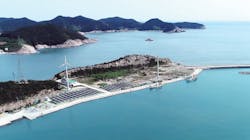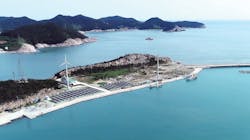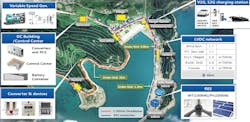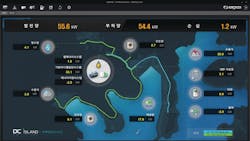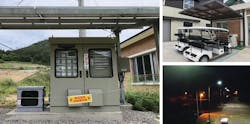Korea Demonstrates DC Distribution System on an Island
At the 1893 Chicago World’s Fair—held in celebration of the 400th anniversary of Columbus' discovery of the American continent—as U.S. President Cleveland pressed a button, 250,000 light bulbs lit up the fair. The electricity used for this memorable event was an alternating current (ac) invented by Tesla, and Edison's direct current (dc) has gone downhill ever since. In the 20th century, electricity generation was dominated by coal, gas and hydropower using rotating turbines. The electricity was generated with ac because electrical power could be transmitted over longer distances with lower losses.
Now, in the 21st century, photovoltaic power generation, hydrogen fuel cells and the representative renewable energy sources generate dc. In addition, most electronic appliances like refrigerators and washing machines use dc. Cell phones and lithium-ion batteries in electric vehicles (EVs), with 18.7 million U.S supplies expected by 2030, also use dc.
As the current power system adopts ac transmission as the standard, dc electricity generated from solar power, wind power and fuel cells is converted into ac, which is then converted back to dc through ac-dc converters installed in the home and mobile devices. Even under the assumption the conversion efficiency of each stage is on the high end at 90%, Korea Electric Power Corp. (KEPCO) estimates a power loss of approximately 30% occurs after undergoing three stages of conversion and reconversion.
DC Distribution System
To reduce the power loss that occurs during the conversion process, a dc system is proactively introduced by internet data centers (IDCs), which consume considerable power. In 2008, Lawrence Berkeley National Laboratory demonstrated a dc distribution system has the potential of using 28% less energy than the typical ac system. In Korea, a dc-based telecom data center also demonstrated a 13.2% improvement in efficiency with the implementation of a dc distribution system.
With internet access and operation as its main function, an IDC consumes electricity on a vast scale. On a global scale, its power consumption is up to 3% of all electricity generated on the planet. Its power facilities, cooling equipment, and air-conditioning systems are operated 24 hours continuously each day to ensure stability and reliability of the center.
There have been several challenges in deploying dc systems. When voltage is low, the resistance loss of dc systems increases. Thus, the wire needs to be thickened, which inevitably results in increased cost. On the other hand, when the voltage is high enough, such as several kilovolts, problems such as arc or electric shock can occur. Safety and protection are two of the main concerns associated with dc distribution. It can be challenging to break a dc fault current compared to an ac current because dc currents do not cross a zero point. It is during a zero crossing of the current waveform when fault interrupting devices can break the currents.
In the case of ac systems, as its voltage crosses zero point about 100 times, the arc is eliminated spontaneously and immediately. However, because the dc system maintains constant voltage at the rated value, the arc is sustained. The undesired arc can cause substantial damage and harm, and even lead to a fire. To address these problems related to optimal voltage and safety, an on-site demonstration test of the dc distribution system and standardization are essential.
Demonstration Projects
Since 2007, the Nippon Telegraph and Telephone Corp. (NTT) in Japan has been conducting an on-site demonstration project of the dc distribution system as well as a campus-scale experiment with 380 V dc. The Electric Power Research Institute (EPRI) developed an intelligent, multifunctional transformer capable of dc supply at various voltages. The prototype was produced in 2009. In addition, ABB constructed a dc distribution system on a ship to reduce fuel consumption by 10% or higher. While there has been much interest in dc distribution systems, this system implementation is still carried out at the level of demonstration projects.
The Seogeochado dc island construction project, conducted by KEPCO Research Institute, is currently the world's largest dc distribution network demonstration project. In this system, instead of ac, dc power lines of 1500 V are constructed and dc generators—such as solar power generators, wind power generators, fuel cells and diesel generators—are interconnected for domestic electricity supply. In addition, light-emitting diode (LED) streetlights, electric cars and charging stations are installed for residents in the region.
Because of the growing number of solar power and energy storage systems (ESSs) that generate dc as well as the increase in LED lighting, digital devices and EVs that consume dc, dc distribution technology has been developed for energy efficiency by connecting directly to dc without having to convert to ac. With the spread of renewable energy sources and an increase in digital loads, demand for a dc power grid is increasing. To spearhead the dc distribution system business, KEPCO has constructed a dc island. While still in an early stage globally, the dc island has operated successfully in a pilot.
Less Conversion, More Efficiency
The KEPCO Research Institute designed dc-based electric power sources, renewable sources, customer facilities and distribution lines. Then it developed an integrated operation system with a dc distribution system and applied it to the island’s power grid. Instead of the 6.6-kV ac in Seogeochado, a 1500-V dc (±750-V) distribution line—as well as a solar power generator (200 kW), a wind power generator (100 kW), an ESS (1.5 MWh) and a variable-speed diesel generator (200 kW) interconnected with the dc distribution line—was built. The dc-generated power was supplied to residential homes.
By reducing the power conversion loss of renewable sources and home appliances, the efficiency of the power system’s energy use improved by more than 10% and stable dc power was supplied to customer in the pilot. As a result, KEPCO Research Institute is speeding up the standardization of its dc distribution system as well as its large-scale on-site experiments. In March 2020, a memorandum of understanding was signed with the Korea Electronics Technology Institute, where organizations announced their commitment to research collaboration in the field of dc distribution system operation technology and standardization technology that can be applied to solar power, batteries and the internet of things market.
In 2020, for the dissemination and commercialization of dc distribution, a 1-MW DC power supply system construction project for supplying power to dc building will be launched. “KEPCO Research Institute plans to continue investing in the demonstration and standardization of the dc distribution system,” a KEPCO official commented. “We aim to contribute to the government-driven solar power and hydrogen fuel cell projects.”
When the demonstration test and standardization process at the Seogeochado dc distribution system are completed, dc-based distribution systems with renewable sources will start to be deployed throughout Korea.
Juyong Kim ([email protected]) leads distribution planning group at KEPCO Research Institute. He is responsible for low-voltage dc distribution and dc microgrid projects in Korea and is also developing the management system for the medium-voltage dc distribution system with interconnection of large-scale renewable sources and digital loads. He received his master’s and Ph.D. degrees in electrical and electronic engineering from Kyungpook National University, Daegu, Korea, in 1994 and 2007, respectively. He joined KEPCO in 1994 and has 27 year of experience in the power distribution industry.
Jintae Cho ([email protected]) is currently a senior researcher in the Smart Power Distribution Lab of KEPCO Research Institute. He received the BSEE and MSEE degrees from Korea University, Seoul, Korea, in 2006 and 2008, respectively, and is working toward a Ph.D. degree in the area of dc distribution. His research interests include protection, monitoring and control of the dc distribution system.
For More Information:
ABB | www.abb.com
EPRI | www.epri.com
NTT | www.ntt.co.jp
About the Author
Juyong Kim
Kim Juyong ([email protected]) received his M.S. and Ph.D. degrees in electrical and electronic engineering from Kyungpook National University, Daegu, Korea, in 1994 and 2007, respectively. He joined the Korea Electric Power Research Institute of the Korea Electric Power Corp. (KEPCO) in 1994. His current research interests include design and control of the direct-current distribution system
Jintae Cho
Jintae Cho ([email protected]) received BSEE and MSEE degrees from Korea University, Seoul, Korea, in 2006 and 2008, respectively, and he is working toward a Ph.D. degree in the area of direct-current distribution. He currently is a senior researcher at the Smart Power Distribution Lab of the Korea Electric Power Research Institute of the Korea Electric Power Corp. (KEPCO), located in Daejeon, Korea. His research interests include protection, monitoring and control of the low-voltage dc distribution system.
